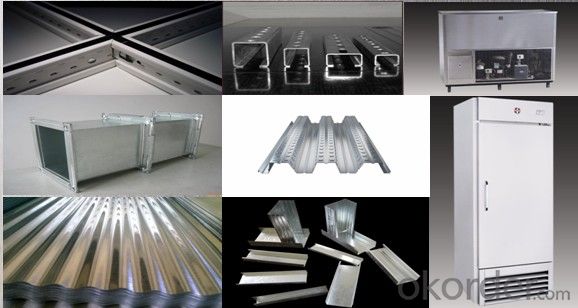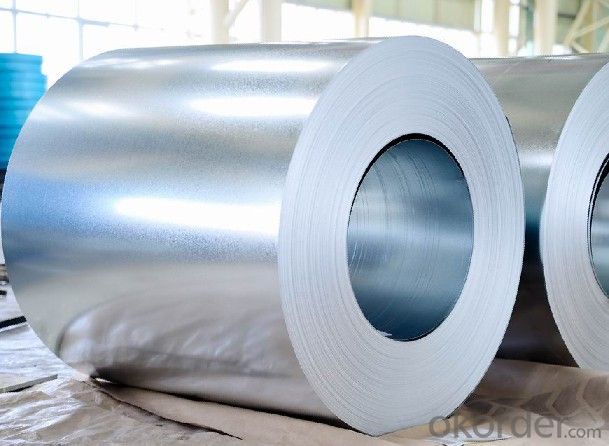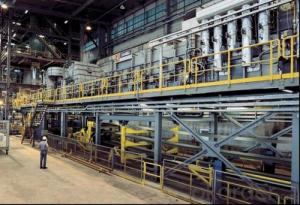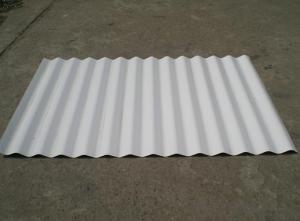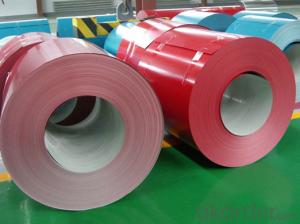Hot DIP Galvanized Steel Coils Regular 1000mm 1200mm 1250mm
- Loading Port:
- China main port
- Payment Terms:
- TT OR LC
- Min Order Qty:
- 25 m.t.
- Supply Capability:
- 1000 m.t./month
OKorder Service Pledge
OKorder Financial Service
You Might Also Like
Product Description
Description:
EN 10147 Structure hot dip galvanized steel coil S250GD+Z, S350GD+Z (SGC340, SS275, SS340)/Custom Deep drawing hot dip galvanized steel coil DX52D+Z, DX53D+Z, S
Galvanized steel is taken cold rolled steel as the base metal, after continuous hot dip galvanizing process, the product produced is an excellent resistance to atmospheric corrosion coating steel coil, as the steel gets coated in layers of zinc and rust won't attach this protective metal; Cold rolled plate by hot-dip galvanizing may extend the service life of 15-20 years.
For countless outdoor, marine, or industrial applications, galvanized steel is an essential fabrication component. Hot dip galvanized steel is used in applications where steel may be exposed to weather, but where stainless steel is too expensive.
Application:
Construction
Manufacture anticorrosion, industrial and civil architecture roof boarding, roof grille
Light industries
Home appliance's case, civil chimney, kitchen utensils
Auto industry
Corrosion resistant parts of cars
Agriculture
Food storage, meat and aquatic products' freezing and processing equipment
Commerce
Equipments to store and transport materials, and packing implements
andard | EN 10142 | DX51D+Z, DX52D+Z, DX53D+Z |
JIS G3321 | SGCC, SGCD, SGCDD, SGC400 | |
ASTM A792M | CS type C, CS type B, DS, SS250 | |
Base Metal | Cold rolled steel coils SPCC, SPCD, SPCE, DC01, DC03, DC04, CS, DS, DDS, Q195, Q250, Q350 | |
Thickness | 0.14mm-3.0mm | |
Width | 600mm-1600mm | |
Coil ID | 508mm, 610mm | |
Zinc coating | 60g/m2-450g/m2 | |
Surface treating | chromium free passivation, chromium passivation, fingerprint resistant, oiled | |
Spangle types | Minimal spangle, zero spangle, regular and big spangle | |
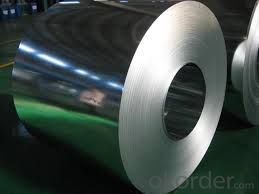
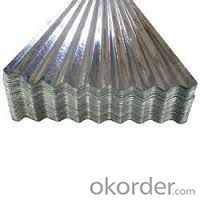
- Q: what do you think about it? Is it a good steel for the money? the knife that i have with that steel is the kershaw chill. good knife for the price
- 8Cr13MoV is a decent blade steel...not a great steel, but about as good as you will generally find without paying much higher prices. It's used by a number of well known knife makers... It's basically equivalent to AUS-8 and will work and hold an edge reasonably well for most basic cutting chores. *************************************** From Wikipedia, the free encyclopedia: 8Cr13MoV, a Chinese stainless steel tempered at the Rc56 to Rc58 range and used in the Tenacious, Persistence, Ambitious, Resilience, Grasshopper, Kiwi3 and Byrd lines of knives. Often compared to AUS-8, but with slightly more Carbon.
- Q: How are steel coils used in the manufacturing of exhaust systems?
- Steel coils are used in the manufacturing of exhaust systems as they are rolled into sheets and then formed into various components such as mufflers, pipes, and catalytic converters. These coils provide the necessary strength, durability, and corrosion resistance required for exhaust system components to withstand high temperatures and harsh conditions.
- Q: Hi All,I was wanting to know,on the quality bikes such as Trek,Giant etc is the aluminum frames as strong as the steel frame bikes? I have heard conflicting reports on this,so thought I would ask here for more input.Thanks!
- Steel is stronger than aluminum. But, you have to consider the strength to weight ratio and stiffness. Modern aluminum frames use hydro-forming to optimize the tube shapes. They also use modern welding and bonding techniques. In short, a good aluminum frame can be better than a steel frame and have less weight. Consider a Cannondale CAAD alloy frame or a hybrid composite/alloy frame such as a Cannondale Six. Cannondale is know for pioneering alloy frames.
- Q: How are steel coils used in the production of steel cables?
- Steel coils are used in the production of steel cables by being uncoiled and straightened, then fed into a machine that twists and braids them together to create the cable.
- Q: I'm pretty sure that this topic has been beaten to death by now. But, I still can't get a definite answer. With stainless steel, you get better corrosion resistance, and you will hold and edge longer. With carbon steel, you will hold a sharper edge, and you could forge a knife blade longer than 2 ft without breakage. I'm personally a fan of stainless steel ( the 440 grade stuff ), just because it seems to hold up to use and abuse better in the long run. HOWEVER, I have NEVER had a factory made knife break on me. I don't think that they would try to sell you a knife that didn't do what it was meant to do, at least to a reasonable degree. (I work for a living, and can't afford a custom $600 knife.) What do you think? Is this a pointless topic? Will there ever be a winner?
- I hate stainless steel! I hate shiny blades also! When I was a kid knifes were awesome! You could actually sharpen them! :) If we bought a new knife we would take an orange and slice it and leave the juice on the blade to purposefully darken it. If you had a shiny blade that looked like stainless you were not cool. :) I think most anyone who had an old knife from back in the 70's or before would agree that these new stainless knives are crap. I have not seen anything perform close to the old blades in stainless. Today I bought a case CV Sod Buster hoping it will perform like the old knives. What reading I have done the Chrome Vanadium is supposed to be like the old steel. I sure hope it is. Now to find some fruit to get rid of this annoying shiny blade! :)
- Q: What are the advantages of using steel coils?
- There are several advantages of using steel coils. Firstly, steel coils are highly durable and can withstand extreme conditions, making them suitable for various applications. Secondly, they provide excellent strength and stability, making them ideal for structural purposes. Additionally, steel coils can be easily molded into different shapes, allowing for customization and versatility in design. Moreover, steel coils have a high recycling rate, making them an environmentally friendly choice. Finally, steel coils offer cost-effectiveness due to their long lifespan and low maintenance requirements.
- Q: How are steel coils inspected for width variations?
- Steel coils are typically inspected for width variations using non-contact laser measurement systems. These systems use lasers to scan the entire surface of the coil and measure the distance between the coil edges at regular intervals. This data is then analyzed to detect any variations in width, allowing for timely adjustments and ensuring the desired specifications are met.
- Q: How are steel coils inspected for flatness using optical sensors?
- The process of inspecting the flatness of steel coils involves the use of optical sensors, which are part of a system known as optical flatness measurement. This system employs high-resolution cameras to capture images of the steel surface as it passes through the inspection line. To begin, the steel coil is unwound and conveyed over a roller table. While in motion, the optical sensors are positioned above the coil to capture images at regular intervals. These sensors are typically a combination of laser line projectors and high-resolution cameras. The laser line projectors emit a thin, straight line of laser light across the width of the steel coil. This laser line serves as a reference plane for measuring the flatness of the steel surface. Subsequently, the high-resolution cameras capture images of the laser line interacting with the steel coil. The captured images are then subjected to analysis using advanced image processing algorithms. These algorithms examine the deformation of the laser line on the steel surface and calculate the deviations from the flat reference plane. These deviations indicate any irregularities or variations in the flatness of the steel coil. The optical sensors possess the capability to accurately detect even the most minute deviations in flatness, measuring them in micrometers or smaller units. This enables manufacturers to identify and correct any flatness issues in the steel coils before further processing or shipment. In addition to measuring flatness, optical sensors can also identify other surface defects such as waviness, scratches, or dents. By incorporating multiple cameras and laser line projectors from different angles, a comprehensive inspection of the steel coil's surface can be achieved. Overall, the utilization of optical sensors for inspecting steel coil flatness offers a swift, precise, and non-contact method. By identifying and addressing any flatness issues early in the production process, manufacturers can guarantee the delivery of top-quality steel products to their customers.
- Q: We all know that when we drop a small steel ball (size 3mm diameter; weight 1.10 grams) and a paper (size 11.7 inches length and 8.3 inches breadth; weight 4.5 grams) from a height. The steel ball will win the race to the ground due to its aerodynamic structure.Now imagine the same steel ball with the same weight converted to the structure similar that of paper. What will be the result? Which object will fall first; steel sheet or paper?
- The 2 objects will have the same size and shape. Therefore they will have the same air resistance. So the heavier object (the sheet of paper) will reach the ground first.
- Q: How are steel coils used in the production of steel chains?
- Steel coils are used in the production of steel chains as the raw material. These coils are fed into a machine called a chain-making machine, which shapes and cuts the steel into individual links. The links are then connected together to form the chain, creating a strong and durable product.
Send your message to us
Hot DIP Galvanized Steel Coils Regular 1000mm 1200mm 1250mm
- Loading Port:
- China main port
- Payment Terms:
- TT OR LC
- Min Order Qty:
- 25 m.t.
- Supply Capability:
- 1000 m.t./month
OKorder Service Pledge
OKorder Financial Service
Similar products
Hot products
Hot Searches
Related keywords



